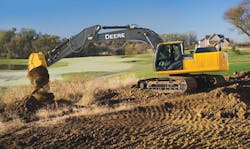Earthmoving Report: G-Series Engine Upgrades Spur Cab Improvements
Deere has begun replacing its D-Series excavators with G-Series machines starting with the 250G, 290G and 350G, rated at 25, 29 and 35 metric tons, respectively. Three larger models—the 470G, 670G and 870G—will be launched later this summer. “Primarily, the big change with the G-Series machines is putting in the emissions-certified engine, making them compliant with the EPA regulations for Interim Tier 4 emissions,” says Mark Wall, excavator product marketing manager. With horsepower ratings of 188 to 271, the excavators are powered by John Deere PowerTech PVX 6.8-liter and 9.0-liter, Tier 4-I engines. To package the new engines, manufacturers typically have had to increase cooling capacity to meet the engine requirements, which requires some machine modifications. “To make room for the new cooling system,” Wall says, “we actually made our frames 8 inches longer. And by doing that, we could take weight out of the excavators by moving the counterweight back, after which we could actually lighten the counterweight while maintaining the same lift capacities. Because lift capacity and stability is affected by center of gravity on the excavator, and we didn’t change our center of gravity—we just moved it back—we actually improved our stability a little bit by getting lighter, and we didn’t change the operating specs of the machine from a lift-capacity standpoint.” Deere also improved the hydraulic efficiency and boasts an 8 percent increase in productivity while working in the HP (high productivity) mode. Wall says 99 percent of the customers he’s talked to typically work in HP mode. “When you really want to dig dirt and go to town, that’s the mode you want to be in,” he says. Of course, fuel consumption will increase when using full power. Two other modes are available: Power mode (P) offers a balance between productivity and fuel economy, and Economy mode (E) will maximize fuel economy for the tractor. Because of the engine update and machine modifications, Deere seized that opportunity to redesign its cab. Although the outside cab dimensions are the same, the inside dimensions are wider because of changes such as switching from a mid-back seat to a high-back seat. The door is 3 inches wider for easier entry and exit, while also providing a little more glass area for improved visibility. In addition, the company completely upgraded the monitor. While it was a liquid crystal before and had a lot of information in it, now it’s even easier to use with more features. “We went to a push-and-dial type access system,” Wall says. “So instead of reaching up to access the monitor on the monitor, the controls for the monitor are actually back on the right-hand-side console. It’s a big rotary dial and you just push down the dial to get to the next screen and then you rotate it to get to the sub-menu, and you can push it again and rotate it to get to what menu you want. So it’s very intuitive to run and operate; you don’t have to lean forward in the seat to get to it.” There is a lot more information in the monitor, similar to what the machines had in the past as far as maintenance intervals, diagnostic codes, languages, attachment settings, etc. But Deere took the radio and HVAC controls, which used to be separate components, and put the controls in the monitor. With Tier 4-I, operators can also get DPF loading and information on diagnostic trouble codes and diagnostic information about what’s going on inside the tractor. Another option or standard, depending on the tractor, is a rearview camera, which was not offered in the D Series. If operators have the camera in the on position, it’s always on, up on the display part of the monitor so they can always see what’s behind them—not just when the machine is in reverse. “We have a great field of vision with that camera,” Wall says. “You can see a person’s toes about 3 feet behind the counterweight. It’s very close, upfront visibility to what’s going on and you can get a good, extensive view away from the tractor also.” Estimated list price for the initial three-model offering is $250,000 to $350,000, depending on configuration.
